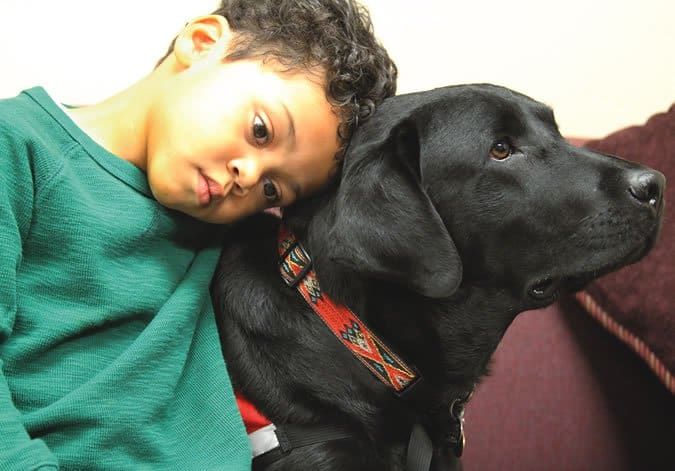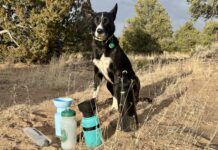His real name is Blake, but his nickname is Batman – a handsome gentleman, ready to swoop in on a moment’s notice to fight crime in his own special way. Blake is a gorgeous, three-year-old Labrador Retriever employed as a courthouse dog for the Pima County Attorney’s Office in Tucson, Arizona. Trained by Assistance Dogs of the West (ADW), and partnered with victim advocate Colleen Phelan, Blake provides support to victims and witnesses of crime as they navigate the vagaries of the judicial process.
Courthouse dogs are professionally trained facility dogs who provide emotional support to people throughout the criminal-justice system. They may begin working with clients upon reception into a safe house or child-advocacy center, or during the process of conducting forensic and medical interviews, or when the case gets to court. While a courthouse dog is not a service dog, per se – the dog does not assist a person with a disability, nor does the dog have public-access rights as would a service dog – courthouse dogs are nonetheless “graduates” of accredited service-dog organizations, and are paired with handlers who are working professionals in the criminal-justice field.
Blake’s Job
At age two, Blake was selected to work in the Pima County Superior and Justice Courts, as well as the Southern Arizona Children’s Advocacy Center. His handler primarily focuses on cases in the Pima County Attorney’s Office Special Victims’ Unit, which prosecutes sexually based offenses with adults and physical/sexually based offenses with children. Phelan and Blake assist individuals from infants to older adults in cases including child molestation, adults who have been sexually assaulted, and babies with injuries caused by traumatic abuse.
According to Phelan, in a very broad sense, Blake provides a basic level of comfort to his charges. When Phelan works with a child (in her role, she’s active during the prosecution phase), the child is more inclined to feel comfortable with her because she has an amazing dog alongside who trusts her. Typically, she says, as children pet the dog, the interaction calms them, and they begin to talk about the trauma they’ve suffered, revealing accounts of sexual or physical abuse. “We help kids get their voices – to feel like somebody’s going to listen. There’s a lot of sitting on the floor and petting the dog while talking to the attorney, whereas typically, pre-Blake, we’d be sitting at a desk more formally,” Phelan notes.
In the courtroom environment – and what is allowed in one courtroom may differ from what is allowed in another – Phelan and Blake may sit quietly at the back of the courtroom, but within a clear line of the child’s sight, while a child is on the stand testifying. Because of the child’s prior interaction with and trust of the team, the child feels a sense of comfort and empowerment while in a potentially terrifying situation.
“While that might look like ‘just a dog sleeping,’ a dog who’s sleeping innately tells us that the environment is okay,” says Jill Felice, ADW’s founder and program director. “Because humans have lived with dogs for the past 20,000 years, when we see a dog who’s relaxed, we know it’s safe. For that child, in that moment, seeing a dog lying there in the courtroom sleeping . . . they know that they’re safe. The way that the dog moves so easily through the process gives people a model to mimic. Everybody is just a little bit calmer, and a little more relaxed, in a situation that is never easy.”
Phelan, who takes Blake home at night, echoes that sentiment. “He teaches me about slowing down and taking my time. Blake is my balance. He helps me to get grounded again, both at home and at work.”
While Phelan is the first to say that her overall wellness has increased (emotionally, spiritually, and physically) because of Blake, she also points out that being responsible for a courthouse dog is an incredible amount of work. While she wouldn’t trade Blake for anything, she explains that her job went from an 8 a.m. to 5 p.m. work day to 24/7.
“Some days I feel a little like Kevin Costner in ‘The Bodyguard’ and Blake is Whitney Houston. He is noticed wherever we go and we are constantly ‘on.’ That took some getting used to, especially when one of us is tired or I am in a hurry.” But she’s quick to add that people are generally a lot nicer when she has Blake, which may seem silly, but is very noticeable!

Temperament and Training
Blake was tapped for this special job as a puppy, in part due to his extremely calm and patient demeanor. His ability to remain focused and “still” during court is critical to his success. Another aspect of his personality is his emotional confidence, or his ability to approach and “take care of” an individual who is crying or upset, while not taking on any of that emotion himself.
Phelan also appreciates Blake’s ability to weave through a courtroom. “While he’s interested in what’s happening, he’s not too interested; he won’t necessarily approach people freely, but if somebody’s interested in him, he likes to be talked to. His personality is like that of an English gentleman,” she says with a smile.
ADW dogs begin training at eight weeks of age, and are trained up until 18 months to two years of age, using positive methods including clicker training. Although the dogs live with professional trainers, the ADW approach is unique in that children help train the dogs in programs that take place in school, after school, and during the summer. In the process, the dogs learn how to respond to being in environments that are crowded with a bunch of children running around, with all the emotional “stuff” that goes on.
During their training, courthouse dogs learn cues that are both navigational and engaging. For example, the “visit” cue asks a dog to lay his head in a person’s lap, and remain still and in that position so that his head can be stroked. As opposed to a dog who jumps on a couch and snuggles up to someone who might not be prepared for that level of contact, the visit behavior and positioning is non-threatening, yet allows for touch.
When the dogs are ready to be placed in an organization within the judicial system, the dog is matched with primary and secondary handlers. The type of environment that is typical for the courtroom he’ll be serving is also taken into consideration when placing the dog. “We want to make placements that are good for the dog, the courtroom, and the person who handles him in that situation,” Felice says.
Therapy Dog?
When I first learned about courthouse dogs a few years ago, I wondered why therapy dogs couldn’t do the job; why a specially trained courthouse dog?
The Courthouse Dogs Founda-tion, a non-profit organization that promotes, educates, and advocates for the use of courthouse dogs in the criminal-justice system by criminal-justice professionals, stands firmly against the practice of using therapy dogs in court. They believe that courthouse dogs should be trained and placed only by accredited service-dog organizations, and handled by professionals in the legal field, since these individuals have an in-depth knowledge of the law and victims’ rights, and understand the confidentiality requirements of the judicial system.
“I love therapy dogs and all the work that they do,” explains Linda Milanesi, Executive Director of ADW. “The courtroom, however, is an environment that is very emotional, much heightened, potentially adversarial and, in a lot of cases, sad and demanding. If an individual doesn’t have the knowledge of the daily activities and workings of the judicial system, they could unknowingly, as a handler and her dog, get a case thrown out of court because of their behavior. It’s a scary place to be if you don’t know what you’re allowed and not allowed to do.” Case closed.
Lisa Rodier lives in Georgia with her husband and Atle the Bouvier, and volunteers with the American Bouvier Rescue League.







Excellent article. Where do these courthouse dogs come from? Are they acquired from accredited breeders from various Kennels or is there a specific breeding programme For them?
Thanks for your continued effort to educate and advocate!